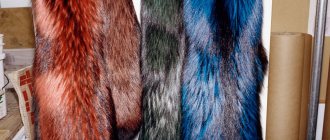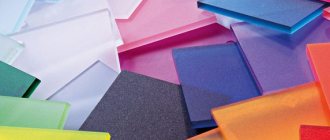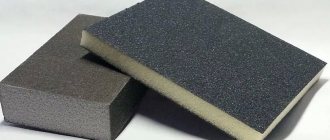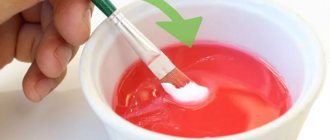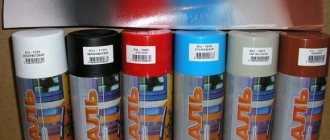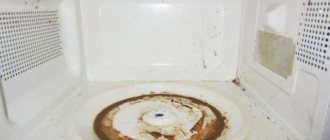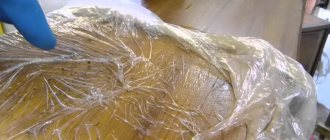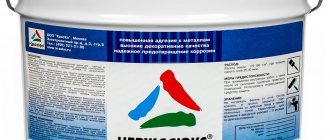This is a rather painstaking process, which sometimes, on the one hand, can be performed by a person without much experience in such work, and on the other hand, can only be performed by a highly qualified specialist. Why is that? It's all about the relief of gypsum 3D panels for walls, for example, panels with a wave-like relief are quite easy to paint, and if the wave is not very small, then it is quite possible to do this using a regular construction roller. But if they have a geometric relief that has cavities that a roller cannot reach, then you cannot do without a pneumatic, electric or, ideally, an airless paint sprayer. Therefore, the optimal solution and the final stage of installation of gypsum 3D panels would be to entrust this work to specialists. So which paint should you choose?
Choosing a dye for gypsum tiles
How to paint the facing material? There are several means that will change the appearance of gypsum tiles:
- Acrylic paint. This is the most common means for painting plaster. This is due to the fact that the composition is easy to apply. It makes it possible not only to give the desired color to the gypsum stone, but also gives it additional properties such as vapor permeability, which allows the tile to actively participate in creating an internal microclimate due to moisture circulation. The acrylic layer provides protection for facing products from external negative influences, reducing the risk of paint cracks on the tiles.
- Vitriol. There are 2 types that are used in painting: iron and copper. The advantage of this product is that it strengthens the painted material. This makes it possible to create stronger resistance to physical damage. Iron sulfate gives gypsum stone a yellowish tint that is quite realistic, allowing this type of painting to be used in any design. Copper sulfate, on the contrary, is more unique because it gives a bluish tint.
- Wood stain. It has a large palette of shades, which allows you to choose the color to your taste. Its advantage is that it provides a clear expression of the structure of the object.
- Drying oil for plaster is not used as often as other dyes, but it allows you to achieve the unique effect of aged stone.
- Rosin mixed with varnish makes it possible to achieve a similar effect to drying oil. The only difference is that it makes the plaster look like aged ceramic.
How to paint artificial stone?
Painting the material at home is usually necessary when purchasing unprocessed products or making products yourself. In the second option, it is better to provide for painting the gypsum mass. This will allow for surface painting only to highlight the desired areas.
If, when making a stone yourself, you take care of its color in advance by adding color to the gypsum mass, then less effort and time will be spent on the entire coloring process
Painting plaster in general is not very easy; it requires care and a lot of time. In addition, the result when choosing a certain color is not always the desired one. Therefore, it is recommended to test all formulations in advance.
For the front coating, various types of dyes can be used to give the parts the desired shade.
Acrylic paint
The water-based solution is quite popular; it allows you to decorate and protect the surface. This material has a number of properties necessary for artificial stone made from a gypsum mixture:
- Elasticity. Cladding elements are subject to thermal expansion, which can lead to the formation of surface cracks. Due to a little elasticity, this problem will be eliminated.
- Vapor permeability. This parameter is very important for plaster, especially inside the house. The fact is that this material helps create a microclimate in the room by absorbing and releasing moisture.
- Resistance to various types of influences. Of course, paint will not protect parts from strong mechanical influence, but it will protect them from ultraviolet radiation and excess water.
Painting with acrylic paint will add additional protective properties to the artificial stone, which is especially important in rooms with temperature changes and high humidity.
If you need to obtain high moisture resistance, purchase a mixture with the addition of silicone. A distinctive feature of acrylic compositions is that they easily change their color; for this, tint is used.
Vitriol
Iron and copper sulfate are used as impregnations. The main purpose of these mixtures is to enhance the strength of parts, but there is also a side effect - coloring. The iron variety gives the stone a yellow tint, and the copper variety gives it a blue tint.
The dry composition is diluted with water in a suitable container, the elements are immersed in the solution for two hours. The main thing is to place the fragments so that they do not touch each other, otherwise stand-out areas will appear.
Vitriol gives the gypsum a beautiful yellow tint, but to achieve a resemblance to natural stone, additional paint is applied to individual sections of the tile.
stain
For gypsum, compositions are mainly used that are also suitable for concrete artificial stones. They are monochromatic mixtures. There is a rich palette of shades, but if necessary, staining is done with wood stain.
There is also an acid stain. It should be handled with great care. Much depends on the composition of the gypsum tiles, so it is recommended to test the mixture on one product.
Painting artificial stone with wood stain
Other types of solutions
Painting can be carried out in other varieties that color the surface of the stone:
- Any options intended for gypsum.
- Varnish of various modifications.
- Impregnations. Many of them not only improve product quality, but also affect appearance. For example, a penetrating mixture with a wet effect adds shine to the surface and creates the illusion of moisture.
- Self-prepared compositions. The main thing is the correct selection of components.
On a note! Currently, special paints have appeared on sale that create the appearance of natural stone. The cost of such materials is high, but the result is impressive.
Specialized paints that imitate natural stone
The best materials for painting gypsum tiles
To paint artificial gypsum stone, acrylic, silicate and silicone paints and varnishes (paint and varnish materials) are used. Most often they are made on a water basis. To paint products intended for finishing external walls, paint and varnish materials that are resistant to external influences are used. Gypsum tiles can be painted in bulk, that is, the coloring pigment is added to the solution before pouring the molds. The entire product receives the main shade. This method is used when installing in places where mechanical damage to the coating is possible.
For surface color application, acrylic paint for plaster is most often used. Ready-made solutions can be purchased at the store or made independently using colored pigments. The combined use of these methods allows you to obtain the effect of natural materials used for finishing.
In order for the paint to better adhere to the surface, it is treated with penetrating primers, and to protect the material from fungi and moisture, gypsum products are impregnated with water repellents. Their use reduces water absorption by 20-25 times. These solutions are applied after varnishing or painting the tiles.
Silicate and silicone paints are mostly used for exterior work. The binder is liquid glass and silicone resins. The service life of such coating is about 20 years.
To create a matte or glossy surface of the material, water-soluble varnishes are used. In addition, they protect the surface of the gypsum stone from abrasion during operation. To create a durable coating, the varnish is applied in several layers. It should be remembered that after such treatment the main color of the gypsum product darkens.
Is it possible to paint tiles with paint?
Do you need special products to paint tiles in the kitchen or bathroom, or is regular wall paint suitable? Definitely required. This is due to 2 factors:
- the specifics of the surface (different types of ceramics);
- rather difficult conditions existing in the bathroom, kitchen - humidity, high temperature, splashes of grease.
Surfaces finished with plaster or covered with ceramic tiles are different - they have different structures, they react differently to painting:
- when painting a plastered wall, the paint freely penetrates into the microscopic pores of the plaster, bonding with its base;
- Ceramic tiles are dense, compact, smooth, so paint has no chance to penetrate its structure and does not adhere well to the surface, so it is necessary to use special products.
When planning to paint tiles in the kitchen or bathroom, you need to remember certain conditions that exist in these rooms. The paint must have the following properties:
- adapted to prolonged contact with moist air, water;
- resistant to cleaning and mechanical damage;
- resistant to detergents, so you can wash walls and floors without fear of damaging the coating.
Partial painting of tiles
Any tile can be partially painted, for example, a decorative pattern or pattern can be applied to it. To do this you need:
- Select a pattern. The easiest way to make a geometric pattern is to cut four strips of electrical tape to the length you need and make a square or diamond shape in the center between the four tiles.
- Apply markings. Using a level, apply the prepared electrical tape between the tiles. If you can’t stick them straight, remove them and re-glue them.
- Prime the surface. Using a small brush, carefully apply a thin layer of primer inside the duct tape squares. Wait until it dries. Do not speed up the process with a hair dryer, as dust may stick to the painted surface.
- Paint the tiles. Apply any color of epoxy paint to the inside of the square.
The incredible simplicity of painting tiles allows anyone to cope with this work, even without painting experience.
What paint should I paint the tiles with?
On store shelves you need to look for products intended for ceramic surfaces, that is, ceramic tiles, terracotta. How can you paint tiles? You should not use the same paints for different types of ceramics. It’s a good idea to buy different products for painting tiles on the floor and walls; these surfaces work with different intensities and are exposed to different influences.
Many paint and varnish compositions are two-component paints for ceramic tiles, mixed immediately before use. These innovative compositions for various types of surfaces are very popular.
From a paint and varnish composition for tiles, we expect strong adhesion to the substrate. You need to choose products taking into account the requirements of a given room - when painting a wall, floor in a bathroom, kitchen, you need to pay attention to resistance to:
You need to think about what type of coating will help achieve the desired effect:
- the matte finish looks elegant and perfectly reflects the subtle appearance of the three-dimensional pattern of the tiles;
- glossy - affects the optical appearance of the room, visually enlarging it.
You can use tile paint to paint the seams of the tiles; you can purchase a special product for painting the seams.
Popular paint options:
- paint V33 – for painting ceramic tiles in the bathroom and kitchen; This is a product for wet areas, resistant to water;
- Instead of V33 restoration paints, you can buy Noxan hydrographic paint - you can use it to paint the inside of the shower stall. While the V33 manufacturer does not recommend constant contact of the painted surface with water, Noxan does not have this problem.
Paint consumption (according to the manufacturer's calculations) providing coverage with one layer:
- Noxan – 5-6 m²/kg;
- V33 – 12 m²/l;
- Flüggera Flutex 10 – 8-10 m²/l.
Subtleties of painting decorative gypsum stone
Sometimes there is a strong desire to change something in the design of an apartment or house. In this case, you can use gypsum stone, painting of which is not as difficult as it seems at first glance. The use of decorative stone will transform any room, but first you need to understand the intricacies of coloring the material.
Paint for ceramic tiles
The main question is how to paint tiles in the bathroom and kitchen. Ceramics are smooth and non-absorbent substrates, and there are many paints for such surfaces. They are not budget ones, but not all are very expensive. There are from the middle price range. Look at the characteristics so that it has high hiding power, strength, and the ability to wash, and with brushes. The surface can be glossy or matte. The degree of gloss and matte varies. This alone gives a sufficient number of options even in one color. You can also use templates, stickers and other methods.
Paint for ceramic tiles can be:
- superurethane enamel;
- epoxy paint;
How the bathtub changed after painting
When you decide to paint the tiles in the bathroom or kitchen, immediately look for a pair - a primer and paint. They must fit one another. Typically, paint manufacturers recommend specific primers. Look through the recommendations, you may find what you need and you won’t have to think about the compatibility of the ingredients.
Recommendations for coloring
Proper painting of gypsum stone involves following simple rules:
- the parts are pre-dried for 1-2 days;
- the old material is sanded, otherwise the paint will fall off soon;
- impregnations are applied according to the instructions on the label - some solutions are applied before the painting procedure, certain types are not compatible with certain paints;
- To give the product shine, a varnish coating is added over the paint, but it is not always appropriate - due to this, the feeling of the naturalness of the stone is lost.
By following these tips, it becomes possible to protect the decorative stone from negative influences and corrosion, and the paint layer will last a long time.
Decor options
Gypsum stone can be used to create an imitation of a brick wall in the interior. With the help of such tiles you can create the effect of both red and white brick, which opens up enormous possibilities when arranging modern interiors. When using certain types of dyes, you can achieve the effect of an antique finish. If you dry the tiles enough and then cover them with drying oil, they will begin to look like marble. Gypsum stone is used to cover the walls either completely or partially. It is also used for finishing individual areas: doors, windows, passages, etc.
Gypsum brick in the interior
What primer to take
The soil must be adhesive, but not the type of concrete contact. It leaves a rough surface, which is unacceptable for painting. After applying the primer, the surface should be smooth, so carefully read the description and composition. If the composition contains quartz sand or other abrasives, this is not our option. You will need a primer with polymers: epoxy, acrylic, polyurethane, etc. In principle, you need to immediately select the paint so that the polymers are compatible.
When painting tiles in the bathroom and kitchen, we are looking for a primer for exterior work. It is precisely designed for use in rooms with high humidity. We can recommend several primers with suitable properties.
- Bostik "Bostik"Undir N. Acrylic water-soluble emulsion. Suitable for old tiles, terracotta, stone tiles. After drying it forms a transparent blue film. Color must be taken into account when choosing paint.
- Tikkurila (Tikkurila):
- Otex. Can be applied to glazed tiles without prior sanding. There are bases in two colors - white or with added color of the desired color. The second option is used for rich tones.
- Otex Akva - Otex Akva. Water-soluble, odorless primer. Can be painted in all colors. An excellent base for bright color, but can also be white or very light. This is if you need light shades.
Different markets may have different designs
Tikkurila adhesive primers have been tested. They were used specifically for painting tiles, but on the walls of the kitchen and bathroom. In order to paint floor tiles, this primer will also work. It will be necessary to choose paint and varnish with high resistance to mechanical stress. Surely there are compositions from other manufacturers.
Technology of applying paint to gypsum stone, preparing the stone for painting
Tinting gypsum stone before installation Source ytimg.com
Painting gypsum stone after its installation Source ogorodsadovod.com
Painting of decorative gypsum stone can be done both before and after its installation on the walls. There will be no significant differences in the technology of work; it is a matter of convenience in each specific situation.
Removing dust with a brush from plaster finish before painting Source laminatepol.ru
In order for the paint to adhere as desired, the decorative stone must be clean. Wipe it clean and remove any other unwanted dirt, including any glue residue. If there are chips or scratches that you want to get rid of, this should also be done before painting.
Dilute the gypsum mixture according to the instructions on the package and cover the problem areas with a spatula, finger or other tool convenient in this situation. Be sure to let these patches dry thoroughly before painting.
Primer for gypsum coating for pre-treatment before painting Source formako.ru
An optional, but desirable step is applying a primer. It will provide stronger, more reliable and durable adhesion of the dye and the surface of the stone. Two important points: the primer must be compatible with the paint, and it must be allowed to dry before painting.
Matt paint
The most popular paints for painting 3d gypsum panels. Due to the matte finish, the coating does not create glare on the surface.
And also, the painting itself does not present any particular difficulties, unless, of course, the seams between the panels are properly sealed and there is no “seam glare.” Conventionally, matte paints can be divided into three types:
- highly matte
- matte
- semi-gloss
The most popular brands of deep matte paint for painting gypsum 3D panels for walls:
High matte:
- Dulux Bindo 3, Bindo 7
- Tikkurila Euro 3, Euro 7
Matte:
- Dulux Classic Color
- Tikkurila Euro Trend
Semi-gloss:
- Dulux Bindo 40
Surface preparation
There are rules that must be followed to obtain the desired effect. Tips for preparing gypsum tiles for painting:
- The facing material must be dry. If the tiles have a certain amount of moisture, they need to be dried.
- If the product has just been purchased or manufactured, then it must spend some time in the microclimate of the room in which it will be used. This way the tile will be able to acquire the appropriate temperature characteristics and moisture levels.
- Then you need to clean the surface of the stone. All dust and dirt must be removed. However, it is necessary to do this with a dry tool - otherwise the stone may become excessively wet.
- In the case where the tile has already been painted, for the desired effect it is necessary to sand it immediately before painting, since the layer of paint that remains can cause a negative effect in the future.
Next, you need to proceed directly to painting using the chosen product and method.
Painting decorative bricks with a sponge
Preparatory work - how to avoid mistakes?
Proper preparation of the base is important.
- First you need to remove furniture, appliances, and equipment from the room that are interfering with the work.
- It is necessary to thoroughly degrease the surface of the tile (get rid of greasy stains and deposits, which can lead to deterioration of the adhesion of the paint layer). You will need water with added detergent and a sponge.
- The seams need to be cleaned. All traces of mold must be removed. For cleaning, special anti-mold products are used.
- Finally, the surface is washed with plenty of water.
Now it's time for renovation work! They include the following steps:
- All scratches, cracks, and cavities must be filled with a special waterproof tile repair compound, which will allow you to achieve a better aesthetic effect. Thanks to grouting, scratches are not visible after painting, walls and floors are effectively protected from moisture penetration.
- For this reason, it is necessary to repair the damaged seams (cracks are filled, grout is applied again). Excess solution is removed.
- The surface is polished and leveled.
- Cleaned from dust.
After protecting the edges of the furniture (if it is impossible to disassemble it), and the places where the tiles meet the wall and floor with masking tape, you can begin painting.
Advice: if possible, you need to dismantle, unscrew, unscrew everything that is possible before painting. This will avoid additional work! Otherwise, after removing the masking tape, you can get the result as shown in the photo below.
Coloring methods
There are two types of coloring: during manufacturing and surface. The first method is used only when the facing material is directly created. When making a mixture for future tiles, an additional pigment is added to the solution, which makes it possible to make the tiles already colored without the need for further painting. The advantage of this method, first of all, is that it saves time on subsequent painting of the gypsum stone. The whole process takes place in production and takes a few minutes - adding the required amount of dye to the solution. The disadvantage of this material is that it is difficult to change it to suit a specific interior. It already has its own color, which will be difficult to correct using surface painting. With surface painting in this case the shade will be ambiguous. The second method - painting already finished tiles - is the most common. It allows you to give the cladding the desired color, and you can do this regularly, changing the design to suit the new interior (the surface is first sanded). You can use different tools for painting. How to paint gypsum tiles:
- Brush. The simplest tool. But its use causes some inconvenience, because it takes the longest. A brush is suitable when you need to paint a small area or highlight individual elements, for example, to make plaster “like a brick”.
- Spray gun. A good option in cases where the entire cladding is painted in one color. It allows you to quickly apply the required number of layers on gypsum stone for the desired effect without any problems.
- Airbrush. Used for more precise work than a spray gun. It is more often used for three-dimensional drawings on gypsum stones as on a canvas.
You should not use a paint roller. This facing material has a non-smooth surface. Because of this, the roller will not be able to evenly apply the coloring composition to the tile, and unpainted areas will remain.
Preparing tiles for painting
Painting tiles belongs to the type of work in which the preparation process is much more complicated and requires more effort and time than performing the task itself. If you are going to paint several tiles, then preparing them will not be a problem. But if you intend to update a wall or the cladding of an entire room, you will have to work hard.
- At the first stage, all tiles will have to be thoroughly washed to remove dirt, grease, and solid deposits that have accumulated on the surface. Their layer, as a rule, is not too thick even in the most neglected room, but it holds firmly and is not easy to wash off. For washing, first a wire sponge, then a regular sponge and a variety of detergents containing abrasives are used. Fine sand can also be used. There is no point in sparing the glazed coating - it must be removed completely, otherwise the paint will not stick. After washing the tile as much as possible with chemicals and abrasives, it is washed again with clean water and left to dry.
Grinding
The purpose of this stage is to remove the glaze from the surface and level the surface of the cladding for painting. This exposes a ceramic base that is porous enough to provide significant levels of paint adhesion and smooth enough to provide an aesthetically pleasing painted surface.
Sanding is done manually using a plaster float with fine sandpaper attached to it using a surface grinder. Using a power tool makes work much faster and easier, but is accompanied by the generation of large amounts of dust. To reduce dust, the surface of the tile can be wetted, but in this case waterproof sandpaper is used. A sanding mesh is used to clean the seams. It is very convenient to wrap the mesh around a spatula, knife blade or other flat hard object and then process the seams.
Primer
Before applying epoxy primer, the wall should be rinsed with clean water and allowed to dry. After this, rinse again to remove any remaining dust and leave the wall for 24 hours for the water to completely evaporate. If you prime wet tiles, sooner or later the water will find its way out and stains, cracks or blisters may appear on the painted surface.
The final stage of painting
After the surface treatment is completed, all that remains is to cover it with several layers of varnish. Sometimes the varnishing step is skipped because many people like the natural matte look of the cladding, reminiscent of natural stones. If acid paint was used for coating, the surface is washed and dried. It is then coated with a hydrophobic compound.
Preparing tiles for painting
From the very beginning you need to wash the base. The paint is applied in a thin layer and even small irregularities - drops of grease, lime stains - everything will be visible. Therefore, we wash and clean thoroughly. If you decide to paint the floor tiles in the bathroom, first remove all silicones, grout, level and clean the seams.
It all starts boringly - with cleaning
Further. If the tile is glazed, it is better to scratch the glaze. There are many ways.
- If you have a grinding machine, this will simplify the task. We use sandpaper with medium grain and make the surface rough.
- You can try a grinder with a grinding attachment. But it will be too dusty.
- Wire brush.
- A block wrapped in coarse or medium grit sandpaper. We select the grain experimentally.
How to paint gypsum tiles on a wall
Every person sooner or later has a desire to change something in the interior of their home. Construction stores are full of materials to satisfy any customer's requirements. Various types of wallpaper, tiles, furniture - everything can be changed. Owners of decorative stone do not have to choose any of the listed materials. Painting decorative stone is quite feasible - it is both simpler and cheaper.
When you wonder how to paint decorative stone, it seems very simple. But this simple job has many pitfalls that it would be nice to know about.
How to paint decorative stone?
The technology assumes that the work will be carried out in stages. The exact procedure allows you to carry out painting without any problems.
Tool selection
The required tool depends on what products need decorative coating. If you paint new parts, the list will be smaller than when working with elements that have an old layer. Also in the second case it is very difficult to achieve a high-quality result.
The following set of devices is being prepared:
- Spray gun. An alternative could be an airbrush.
For more precise detailing, it is better to use an airbrush instead of a spray gun.
- Brushes and sponge. Great for tinting and highlighting.
- Grinding tools. This could be sandpaper or a sander.
- Vacuum cleaner. To remove dust and dirt.
The necessary impregnations and paint (or its components) are also purchased.
Preparing the stone
Preparing the products is not difficult:
- Dust and dirt are removed from parts. It is important to avoid wetting the material.
- If required, the elements are polished.
- The selected type of impregnation is applied. For example, to increase moisture resistance. Depending on the location of the tiles, a water-repellent, antiseptic or other type of impregnation is selected
- Drying is in progress.
All fragments are inspected: defective or improperly shaped ones are not used.
Coating
Decorative stone is painted in different ways, but the general recommendations are as follows:
- For uniform coloring, all fragments are processed individually.
- If work is carried out on a finished surface, then options are immediately thought out that will avoid homogeneity. The most common method is to use relief and cover in two tones. That is, a darker layer is laid first, then the protruding texture is lightly sanded. If necessary, a lighter color is quickly applied after this.
- For painting, it is preferable to use a spray gun; certain lines are highlighted with an airbrush. This will allow the process to be completed much faster. Painting stones with a pronounced relief (which is typical for gypsum products) with a brush is not only tedious, but also does not guarantee a high-quality result.
- An excellent option is to completely immerse the parts in the composition. In this case, the duration depends solely on the individual characteristics of the mixture.
Important! To obtain the desired effect, a trial coloring is carried out to select the shade and application technology.
Decoration
There are several ways to interestingly paint the surface of decorative gypsum stone, with which you can achieve an unusual look for the product:
- Under old marble , a stone made with your own hands is dried, and a store-bought one is placed in a warm, dry place and kept for two days. After this, use a flute brush to impregnate the surface in two layers with heated drying oil. After some time, you will get a coating with an aging effect, reminiscent of marble.
- For terracotta - the technology is similar to creating an ancient marble coating, only it is not drying oil that is used, but rosin and varnish - they are diluted in industrial alcohol.
- With a bronze tint - gypsum stones are thoroughly impregnated with drying oil and dried for 8-10 hours. Then two layers of bronze powder diluted in varnish are applied to the material, and the stone is dried. Take 10 g of silver nitrate, 100 g of vinegar, 300 g of pure water, and prepare a special solution from these components. The product is re-coated with bronze powder and treated with the prepared solution. At the end of the procedure, the decorative stone is wiped with a piece of velvet cloth.
- Application of stain - the composition is slightly heated, gypsum elements are immersed in it for literally 5-10 seconds and sent to dry.
Thanks to these tips, preparation for painting decorative gypsum stone will be productive, and the result of the work will be high-quality and long-lasting.
One method of painting decorative gypsum stone is presented in the following video.
The order of painting the figures
Painting is carried out in a well-ventilated area. Most often, the figurine is painted white as the first layer, so that colored paintwork materials look brighter and more saturated. This technique will further reduce the absorption of gypsum and cement and reduce the consumption of pigmented paint. Afterwards, the material is allowed to dry and a drawing is applied with a pencil to the surface of the figure. Then paint all the details; if necessary, outline the contours in a dark tone. Leave the figure until completely dry for a day and place it in its proper place.
How to strengthen plaster
If plaster figures are used in the garden, it is recommended to use additional products to increase their strength. This is especially important if the products were prepared independently, since in this case industrial hardeners and special modifiers are unlikely to be added to them. Before painting, you can treat the figurine with a solution of 500 ml of water and 50 g of PVA glue, which acts as a reliable primer. No less effective will be the use of ready-made acrylic primer and the application of varnish after painting. It is best to buy weather-resistant yacht varnish on a silicone or polyurethane base with a gloss or pleasant matte finish.
Bronze painting of figurines
The easiest way is to purchase a ready-made composition with a bronze tint, which is used immediately after the base white coating has dried. A cheaper option is to apply nitro varnish with silver or gold pigment, which is sold in dry form. This composition is applied in 2-3 layers, otherwise it will turn out too transparent.
Peculiarities
Protective epoxy varnish solutions consist of epoxy resin diluted in the required proportion with an organic solvent. Most often, this type of varnish is a two-component composition, which is mixed with a special hardener before application.
Epoxy varnish is suitable for application to parquet, wooden floors, wood panels, wooden windows, doors, and other surfaces. In addition, a special epoxy varnish for concrete is produced. Almost every type of epoxy varnish mixture cannot be applied over other paints and varnishes; they must first be removed from the surface.
Briefly about the main thing
Gypsum for decorative stone is used in almost every modern design. This material is a budget and modernized version of conventional brick. It is lighter, easier to install and suitable for all types of surfaces
That is why when choosing an artificial surface, attention is paid to gypsum stone
A large assortment allows you to choose the material for each room. But the types are very different from each other, so it is worth studying in detail the properties of each and comparing them with the technical characteristics of the room
You can do the installation yourself, but it is important to follow all the rules and strictly follow the instructions. Only then will gypsum tiles become an excellent addition to the interior of the house
Is it possible to paint tiles?
From time to time you want to update your interior, and the hardest thing is with coatings that are difficult to replace. These include tiles. And it would be necessary to change it, but when you remember the expenses, the dirt, and you don’t want anything anymore. Therefore, when you are tired of the old tiles, have not yet decided to lay a new one, but want to refresh the appearance, we begin to think about whether it is possible to paint the tiles. In principle, it is possible. But this is a temporary option. And, as a rule, it is not very durable. Everything looks decent from a few months to three to five years. The period until everything looks good depends on:
- Type of tiles. On a glazed surface, there is a high probability that the paint will begin to peel off quickly and peel off. If the surface of the tile is rough, then properly selected and applied tile paint will last for some time.
- Preparing the base. Smooth - glazed - tiles must be made rough. All the rest - wash well and degrease. There will certainly not be a normal result on a dirty or greasy surface.
Paint for ceramic tiles - a way to change its appearance without replacement
- Selected materials. The choice of paint for tiles and primer must be approached carefully and thoughtfully. There are not so few materials and new ones are constantly appearing. Read the description carefully, even if you were told that this is what you need.
- Compliance with technology. Materials for painting tiles are produced by famous companies. In any case, we recommend buying these. They often post technological maps. They describe in detail where, when, how and in what order the work should be carried out. If you follow the recommendations, the result is guaranteed. And, it’s better to read the technology of the work before you buy it. Just believe me.
Let’s say right away that cheap paint for ceramic tiles is a fantasy. There is no such option. The price for materials is decent. Maybe just a small area will help you avoid spending too much.

